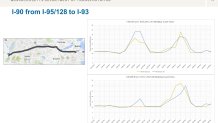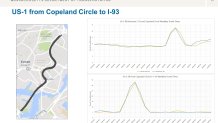
Has traffic seemed much worse around the Boston area since Labor Day? It's not just you.
Drive times got longer on some major highways in the area, according to data from the Massachusetts Department of Transportation provided to NBC10 Boston.
Transportation officials monitoring the Orange Line shutdown had expected more workers on the roads in Massachusetts after Labor Day, when students go back to class and peoples' vacations tend to end. On top of that, this year, some offices were returning to work for the first time since the pandemic.
Get Boston local news, weather forecasts, lifestyle and entertainment stories to your inbox. Sign up for NBC Boston’s newsletters.
For some major routes, the data bore out their worries.
It took 15 minutes longer for commuters to get into Boston on Interstate 93 on the Wednesday morning after Labor Day compared to the Wednesday before it. The drive from I-95 to the Zakim Bridge went from about 35 minutes long during the pre-Labor Day morning rush — still much slower than the 10 minutes the drive takes when roads aren't clogged — up to 50 minutes after the holiday.

The Mass. Pike got slower over the same period as well. The morning rush down I-90 from I-95 to I-93 in Boston got about 12 minutes longer, from around 22 minutes to about 34. The reverse commute out of the city, which didn't have any slowdown the Wednesday before Labor Day, was affected as well — drivers needed an extra seven minutes to make the same trip a week later.

Some traffic did get better after the holiday weekend, including the Turnpike's evening rush, though only slightly. South of Boston, I-93 was faster after Labor Day during both commuters.

And some slowdowns remained unchanged, like Route 1 from Revere down the Tobin Bridge into Charlestown.
State data showed that, no matter when you traveled, the commuters heading into Boston during the morning rush spent up to nearly seven times as long on the road than drivers traveling before 5 a.m. or after 11 a.m. And anyone headed home on the same route in the afternoon spent nearly twice as long during the evening rush.

The data also illustrate just how much traffic drivers deal with every day. Drive times regularly double or triple during the morning rush on roads around the area no matter what day it is — a graphical representation of the molasses-like conditions some commuters have to deal with.
UCLA urban planning professor Michael Manville, who's from Massachusetts, told The Boston Globe Monday that "the idea in people's heads that 'when there is a place to go, I drive there'" didn't change during the pandemic. He's one of the experts who advocates for congestion pricing, in which drivers pay extra to use some roads, adding an economic incentive for drivers to find alternative ways to get to their destinations.



